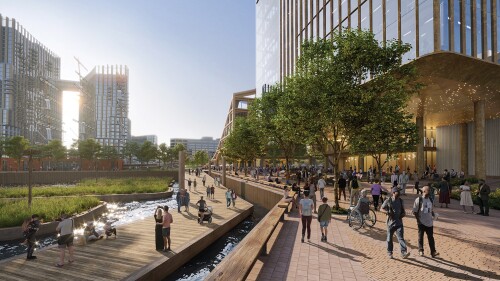Tenants directly account for over 50 percent of building energy use (and thus, a significant portion of building carbon emissions), but owners are often held responsible for whole building energy consumption/decarbonization. How can owners address the tenant’s portion of this? Enter two impactful solutions: green leases and sustainable tenant fitouts.
Building owners and tenants are often characterized by a “split incentive” which hinders joint efforts towards energy-efficient buildings. Why should one party pay for an improvement when the other stands to benefit? The split incentive occurs when the party who pays the upfront costs of an efficiency improvement is different from the one who benefits from future energy savings. This is oftentimes the case in standard commercial leases, which lay out how energy costs are divided between tenants and owners in ways that discourage energy savings.
“Timing is everything when it comes to tenants. If you don’t take advantage of those opportune moments to make sustainability improvements, it’s nearly impossible (and far less cost-effective) to shoehorn them in later. That’s why it’s so terrific that programs exist to support greening the lease process and the fit-out process. We need to leverage every tool in the toolbox to accelerate decarbonization of the building sector toward net zero.” Marta Schantz, Urban Land Institute
Both parties – owners and tenants - play a vital role in embedding sustainability into the built environment and ultimately have common ground that can be leveraged to achieve shared goals. This guide previews The Urban Land Institute’s (ULI) Tenant Energy Optimization Program (TEOP) and the Institute for Market Transformation (IMT) and U.S. Department of Energy’s (DOE) Green Lease Leaders program, highlighting their actionable steps for landlord-tenant collaboration in advancing sustainability in leased spaces.
- Green Lease Leaders is a national recognition and education program honoring landlords, tenants, and partnering real estate practitioners that incorporate green leasing to drive high-performance and healthy buildings. Those so honored encompass a range of businesses in the commercial, retail, industrial, information technology, and multifamily sectors.
- The Tenant Energy Optimization Program (TEOP) process walks tenants and their teams through a 10-step process that helps leased spaces achieve deep energy and financial savings. From pre-lease, through design and construction, to post-occupancy, following the TEOP 10 steps ensures that energy efficiency is cost-effectively included from the beginning to end of a fit-out process.
“Green Lease Leaders has set the standard for what constitutes a green lease, providing fundamental guidance for incorporating energy efficiency in a lease. Green leasing also goes beyond a legal binding document because it incorporates critical decision-making opportunities during site selection through operations, as outlined in the TEOP 10 step program. By adopting the guidance from these two programs landlords and tenants can solve the split incentive, do so equitably, and achieve sustained energy savings.” Audi Banny, Institute for Market Transformation
The Green Lease Leaders’ program requirements and TEOP 10 steps share complementary parameters, and their crossover addresses similar areas of landlord-tenant collaboration towards sustainability. When paired together and integrated into the tenant lease lifecycle, these programs can offer a robust roadmap for energy efficiency and decarbonization achievements from pre-lease to post-occupancy. A green lease, after all, can stipulate requirements of a sustainable fit-out as well as details of post-occupancy operations—both of which are key aspects of TEOP. The organizations recently released a 3-page reference guide to show in more detail how the programs can be used together.
A great example of this overlap is from Brandywine Realty Trust. They are a 2020 Gold Green Lease Leader and have a TEOP case study with a law firm tenant ReedSmith at an office property in Philadelphia.
Brandywine incorporates key sustainability language into its leases, covering issues such as chemical use, indoor air quality, energy efficiency, water efficiency, recycling, and other strategies to drive shared cost savings that benefit both tenant and landlord. To overcome the split incentive barrier to energy efficiency, Brandywine includes a clause in all leases that allows them to charge tenants for measures that result in operational expenditure savings, such as lighting or chiller retrofits, so long as the operational savings are greater than the costs of the efficiency measure. Brandywine and tenants negotiate the time frame for payments, and the tenant accrues utility saving benefits after the investment is fully paid. This mechanism creates a win-win situation for Brandywine and tenants: tenants benefit from overall savings as a result of the efficiency measure, while Brandywine benefits from improving building assets and maintaining or increasing the value of the building.
For its ReedSmith tenant space in particular, Brandywine recommended the TEOP fit-out strategy which resulted in a 44.5 percent energy reduction compared to baseline consumption and the incremental costs were paid back within 2.2 years. The savings resulted from a combination of efficient lighting strategies, ENERGY STAR equipment, advanced power strips and outlet controls, and variable drives on air-handling units. The experience gained from implementing the Tenant Energy Optimization process within Reed Smith’s Philadelphia office space created a more intense focus and serious consideration of the financial returns that can be realized through investments in energy efficiency.
“With the increasing need for building owners to significantly reduce energy and the carbon footprint of their portfolios, addressing common areas only is not enough. Optimized and sustainable tenant spaces are a key piece of the puzzle and at Brandywine we utilize green lease language and sustainable tenant fit out guides and guidelines to ensure our tenants have the right tools in place to create extraordinary spaces that are optimized for efficiency and enhance human health and wellness.” Ronald Becker, Brandywine Realty Trust
Looking even further, real estate investors and clients have increasingly pushed for a more equitable and sustainable future, supporting new building performance policies and pledging to substantially reduce their carbon emissions. In recognition of all of this, IMT and the Better Buildings Alliance launched a Platinum-level of the Green Lease Leaders program, which seeks to address the greater ESG impact of leasing practices.
Are you interested in becoming a Green Lease Leader? Applications for this year’s recognition are due March 31st. Landlords and tenants can submit application at https://www.greenleaseleaders.com/apply/.







